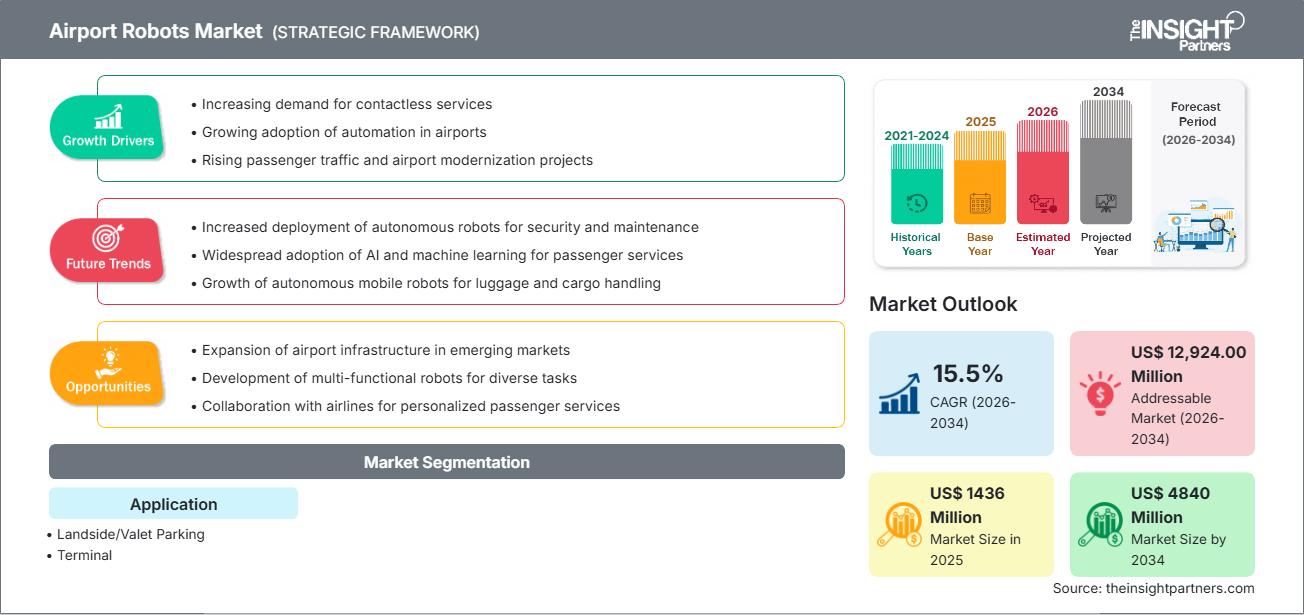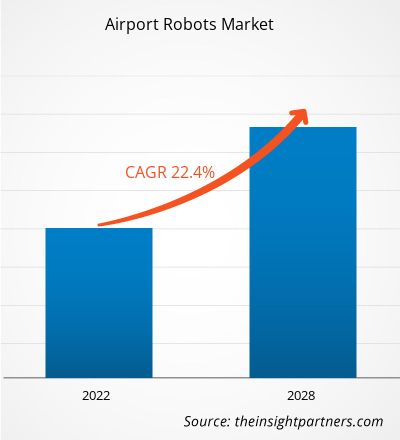Se espera que el tamaño del mercado de robots aeroportuarios crezca de US$1436 millones en 2025 a US$4840 millones en 2034, registrando una CAGR del 15,5% durante el período de pronóstico (2026-2034).
Análisis del mercado de robots aeroportuarios
La mayor automatización en los aeropuertos, la creciente concienciación sobre la seguridad, la presión sobre los costes laborales y la creciente demanda de mejores experiencias para los pasajeros impulsarán el crecimiento del mercado de robots aeroportuarios a un ritmo acelerado. Los aeropuertos implementan cada vez más robots de servicio para la atención al pasajero, la limpieza, la gestión de equipaje e incluso la seguridad, con el fin de reducir la dependencia de la mano de obra humana y garantizar flujos de trabajo fluidos. La integración de la IA, la visión artificial, el reconocimiento facial y los sensores mejorados acelera aún más este crecimiento.
Además, las fuertes inversiones en infraestructura aeroportuaria en todo el mundo, especialmente en los mercados emergentes, junto con los planes de modernización de los gobiernos, siguen impulsando la demanda. Los robots no solo mejoran la eficiencia operativa, sino que también contribuyen a una mayor seguridad e higiene, algo crucial en el mundo pos-COVID.
Descripción general del mercado de robots aeroportuarios
Los robots aeroportuarios son sistemas robóticos especializados, autónomos o semiautónomos, que se despliegan en aeropuertos y realizan tareas que abarcan desde la orientación de pasajeros, los controles de seguridad, la gestión de equipaje y la limpieza, hasta diversas funciones operativas. Estos robots ayudan a automatizar numerosos procesos repetitivos y que consumen muchos recursos, mejorando la eficiencia de los servicios y reduciendo así la mano de obra y el riesgo operativo.
Con el aumento del tráfico de pasajeros y las expectativas de una experiencia aeroportuaria fluida y sin contacto, estos sistemas robóticos desempeñan un papel fundamental en la modernización del funcionamiento de los aeropuertos. Su adopción abarca tanto la experiencia inicial del viajero, como los quioscos de información y la orientación, como las operaciones posteriores, como la limpieza, la vigilancia y la logística.
Personalice este informe según sus necesidades
Obtendrá personalización en cualquier informe, sin cargo, incluidas partes de este informe o análisis a nivel de país, paquete de datos de Excel, así como también grandes ofertas y descuentos para empresas emergentes y universidades.
Mercado de robots aeroportuarios: Perspectivas estratégicas

-
Obtenga las principales tendencias clave del mercado de este informe.Esta muestra GRATUITA incluirá análisis de datos, desde tendencias del mercado hasta estimaciones y pronósticos.
Impulsores y oportunidades del mercado de robots aeroportuarios
Factores impulsores del mercado:
- Automatización de seguridad y detección de amenazas: el aumento de las amenazas a la seguridad alienta a los aeropuertos a implementar robots equipados con sensores, cámaras y reconocimiento facial para monitorear multitudes, detectar anomalías y escanear en busca de contrabando.
- Imperativos de eficiencia operativa: Los aeropuertos están bajo presión continua para reducir los costos laborales y optimizar las operaciones; los robots pueden realizar tareas incansablemente, reduciendo la dependencia de la mano de obra manual para la limpieza, el manejo de equipaje y la vigilancia.
- Expansión y modernización de infraestructura: Muchos gobiernos están invirtiendo en la construcción o expansión de aeropuertos, lo que ofrece oportunidades para integrar la robótica en las primeras etapas del diseño aeroportuario. Por ejemplo, el informe de Insight Partners señala que la construcción de nuevos aeropuertos en países como China e India es un importante motor de crecimiento.
Oportunidades de mercado:
- Crecimiento en los mercados emergentes: el rápido desarrollo y el aumento de la capacidad aeroportuaria en las economías emergentes proporcionan un terreno fértil para el despliegue de robots.
- Integración de IA y visión: el uso de IA para la navegación, la interacción de voz y el análisis de multitudes puede hacer que los robots de los aeropuertos sean más inteligentes y aumentar su utilidad para las funciones de atención al pasajero.
- Innovación en servicios: existe potencial para ampliar casos de uso, por ejemplo, asistencia a pasajeros multilingües, remolque de equipaje autónomo, limpieza y robots autónomos de valet parking.
- Asociaciones con fabricantes de equipos originales (OEM) de robótica: los aeropuertos pueden asociarse con fabricantes de robótica y empresas de inteligencia artificial para desarrollar conjuntamente soluciones robóticas personalizadas y optimizadas para sus diseños, perfiles de pasajeros y requisitos regulatorios.
Análisis de segmentación del informe de mercado de robots aeroportuarios
La segmentación a continuación sigue la estructura que se utiliza habitualmente en el análisis de The Insight Partners:
Por aplicación:
- Estacionamiento en tierra / Valet
- Terminal
Por geografía:
- América del norte
- Europa
- Asia Pacífico
- América del Sur y Central
- Oriente Medio y África
Perspectivas regionales del mercado de robots aeroportuarios
Los analistas de The Insight Partners han explicado detalladamente las tendencias y los factores regionales que influyen en el mercado de robots aeroportuarios durante el período de pronóstico. Esta sección también analiza los segmentos y la geografía del mercado de robots aeroportuarios en Norteamérica, Europa, Asia Pacífico, Oriente Medio y África, y Sudamérica y Centroamérica.
Alcance del informe de mercado de robots aeroportuarios
| Atributo del informe | Detalles |
|---|---|
| Tamaño del mercado en 2025 | US$ 1436 millones |
| Tamaño del mercado en 2034 | US$ 4.840 millones |
| CAGR global (2026-2034) | ?15,5% |
| Datos históricos | 2021-2024 |
| Período de pronóstico | 2026-2034 |
| Segmentos cubiertos |
Por aplicación
|
| Regiones y países cubiertos |
América del norte
|
| Líderes del mercado y perfiles de empresas clave |
|
Densidad de actores del mercado de robots aeroportuarios: comprensión de su impacto en la dinámica empresarial
El mercado de robots aeroportuarios está creciendo rápidamente, impulsado por la creciente demanda de los usuarios finales debido a factores como la evolución de las preferencias de los consumidores, los avances tecnológicos y un mayor conocimiento de los beneficios del producto. A medida que aumenta la demanda, las empresas amplían su oferta, innovan para satisfacer las necesidades de los consumidores y aprovechan las tendencias emergentes, lo que impulsa aún más el crecimiento del mercado.

- Obtenga una descripción general de los principales actores clave del mercado de robots aeroportuarios
Análisis de la cuota de mercado de robots aeroportuarios por geografía
El informe de The Insight Partners proporciona un desglose regional para mostrar cómo varía la demanda en diferentes geografías:
América del norte
- Cuota de mercado e importancia: Históricamente líder en adopción debido a una sólida infraestructura de aviación, altos estándares de seguridad y un mayor gasto per cápita en tecnología.
- Factores clave: cumplimiento normativo, presiones sobre los costos laborales e integración de la robótica en las operaciones de cara al pasajero y en el back-end.
Europa
- Cuota de mercado e importancia: Fuerte presencia debido a aeropuertos avanzados y altos estándares de seguridad y regulatorios.
- Factores clave: Enfoque en la automatización, la sostenibilidad y la eficiencia en las operaciones aeroportuarias.
Asia Pacífico
- Trayectoria de crecimiento: Se espera que sea una región de alto crecimiento, respaldada por un rápido desarrollo de la infraestructura aeroportuaria, un fuerte crecimiento de pasajeros y políticas gubernamentales favorables.
- Tendencias: Adopción de robots con IA para asistencia a pasajeros, seguridad y limpieza; aumento de las colaboraciones con empresas de robótica.
América del Sur y Central
- Potencial del mercado: Sector de la aviación en crecimiento; potencial para la adopción de robótica a medida que se construyen o modernizan aeropuertos más nuevos.
Oriente Medio y África
- Oportunidades: Ambiciosos planes de expansión aeroportuaria; creciente interés en tecnologías aeroportuarias avanzadas para gestionar grandes volúmenes de pasajeros y garantizar la seguridad.
Densidad de actores del mercado de robots aeroportuarios: comprensión de su impacto en la dinámica empresarial
Estrategias competitivas observadas:
- Asociaciones entre aeropuertos y fabricantes de equipos originales (OEM) de robótica para co-crear robots personalizados.
- El desarrollo de robots más autónomos y controlados por IA que maximicen el valor y minimicen la intervención.
- Énfasis en la interoperabilidad: integración de robots con sistemas de gestión aeroportuaria, protocolos de seguridad y sistemas de datos de pasajeros.
- Enfatizar la confiabilidad de los robots, la duración de la batería y las certificaciones de seguridad para cumplir con las estrictas regulaciones de aviación.
Oportunidades y movimientos estratégicos:
- Los proveedores pueden asociarse con los gobiernos para aprovechar los programas de modernización de aeropuertos.
- Desarrollo conjunto de robots multilingües que interactúan con los pasajeros para mejorar la experiencia del cliente y la diferenciación del servicio.
- Invertir en I+D para reducir los costos de los robots (hardware + software) para que las implementaciones sean económicamente viables incluso para aeropuertos más pequeños.
Actores clave del mercado:
- Compañía de robots Yujin, Ltd.
- Corporación Avidbots.
- CIBERDYNE INC.
- Robótica de SoftBank
- Stanley Robotics SAS
- SITA
- ABB Ltd
- Grupo ECA
- Electrónica LG
Otros actores del mercado analizados durante la investigación:
- Universal Robots A/S
- Siemens AG
- Grupo Thales
- Industrias Vanderlande
- Dinámica de Boston
- Honeywell International Inc.
- KUKA AG
- BlueBotics SA
- Robots UVD
Noticias y desarrollos recientes del mercado de robots aeroportuarios
- El informe de Insight Partners destaca el creciente interés y el despliegue de robots de seguridad con reconocimiento facial y capacidades de teledetección en varios aeropuertos.
- Stanley Robotics ha estado operando sistemas robóticos autónomos de valet parking en estacionamientos de aeropuertos, liberando espacio en el suelo y aumentando la eficiencia.
- Los aeropuertos en las economías emergentes (por ejemplo, en Asia) están invirtiendo cada vez más en robots de limpieza y asistencia a los pasajeros, impulsados tanto por la expansión de la capacidad como por la necesidad de servicios sin contacto.
- Los fabricantes de equipos originales (OEM) están desarrollando sistemas robóticos de próxima generación con mayor duración de batería, mejor navegación con IA e interacciones multimodales (voz + tacto) para atender a diversos perfiles de pasajeros.
Informe de mercado sobre robots aeroportuarios: cobertura y resultados
El informe «Mercado de robots aeroportuarios: pronóstico hasta 2034» de The Insight Partners abarca:
- Tamaño y pronósticos del mercado global y regional (2021-2034)
- Dinámica del mercado: impulsores, restricciones, oportunidades y tendencias
- Evaluación del impacto de la COVID-19 en la adopción de la robótica aeroportuaria
- Análisis de segmentación: por tipo, aplicación, usuario final, geografía
- Análisis PEST (Político, Económico, Social, Tecnológico) y análisis FODA
- Panorama competitivo: concentración del mercado, mapa de calor de los principales actores, estrategias
- Perfiles detallados de empresas de los actores clave: SITA, SoftBank Robotics, Stanley Robotics, ABB, LG Electronics, CYBERDYNE, Yujin Robot, etc.
- Análisis histórico (2 años), año base, pronóstico (7 años) con CAGR
- Análisis PEST y FODA
- Tamaño del mercado, valor/volumen: global, regional y nacional
- Industria y panorama competitivo
- Conjunto de datos de Excel
Informes recientes
Testimonios
Razón para comprar
- Toma de decisiones informada
- Comprensión de la dinámica del mercado
- Análisis competitivo
- Información sobre clientes
- Pronósticos del mercado
- Mitigación de riesgos
- Planificación estratégica
- Justificación de la inversión
- Identificación de mercados emergentes
- Mejora de las estrategias de marketing
- Impulso de la eficiencia operativa
- Alineación con las tendencias regulatorias






















 Obtenga una muestra gratuita para - Mercado de robots aeroportuarios
Obtenga una muestra gratuita para - Mercado de robots aeroportuarios